Key Competencies Kit
for Facing Lifelong Learning


 |
This Project has been funded with support from the European Commission. This communication reflects the views only of the author, and the Commission can not be held responsible for any use which may be made of the information contained therein. |
 |
Upon completion of this unit you shall be able to:
Within the context of human relationships, communication plays a very important role. People use it to create and develop all kind of relationships: work, family, community, friendly relationships, etc.
Just imagine that you had to spend a whole day without communicating with anyone, that is, you cannot talk, write, or sign…just try for a few minutes. You will realise that living without communicating is really difficult. As a matter of fact, people need to communicate. However, we don’t always do it in the best way. In order to improve this skill that is so important for your personal development, you need to train and make use of some of the measures presented in this unit. Before starting, we want you to reflect upon the following questions:
What does the title of this unit suggest to you?
Which language do you think is your mother tongue? If you know that: What do you use it for?
How do you interact with the people in your environment?
Which tools do you use to make the people around you aware of what you need, what you like, what you find boring…?
In this section, we try to define what we mean when we use the concept of communication. In addition, we go beyond this, and we try to define the elements and the process of communication, that is, which is the path that people follow in order to communicate.
Below, we propose several settings:
|
|
|
1. Two relatives hug each other in a sad mood at the bus station. |
2. A driver blows his/her car’s horn as a pedestrian is crossing the pedestrian crossing when the red light is on. |
3. A child cries at the school door and hugs his father. |
 |
What do these settings suggest to you?
|
In the settings we have presented we have probably made the right interpretations. As a matter of fact, if we analyze our environment, what people say or do is providing us with important information to understand how they feel and think.
There’s a common aspect to all these settings: an exchange of information is taking place.
Communication is a process by which two or more people exchange information, ideas and emotions. It is a mutual1 process where information can be transfered in several ways: verbal (through speech and writing) and non-verbal (through gestures and behaviours). |
Even though the terms information and communication are related, they refer to different settings. Communication is a mutual process (a person issues a message, and the person receiving it issues an answer), whereas information is a partialprocess (a person issues a message, and there is no need for an answer coming from another person). |
 |
 |
If you analyze it carefully, in the previous definition we have mentioned that communication is a process, that is, there are several elements that must combine with each other and act in different ways. In order to verify this, let’s take the following situation as a reference:
|
It is clear that there is communication going on in this situation, you can see that an exchange of information between two people is taking place.
But… How does the exchange of information take place?
 |
Try and answer the following questions:
|
Communication is a process where:
|
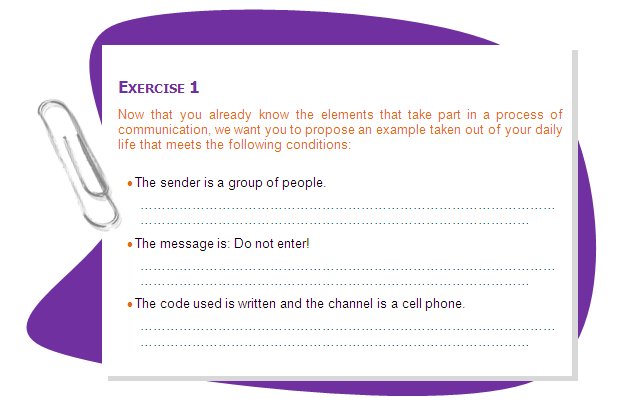
Now that we already know all the elements that take part in the communication process, we can move one step forward and establish how are these elements organized in order to set up the communication process.
 |
|
In fact, with just a smile, a verbal answer to your message, a movement of the hands or arms, you can already identify whether the message has arrived or not.
|
 |
Order properly the following sequence:
![]()
 |
Reflect upon the organization of the communication process, and especially, upon what you have done in each of these moments. |
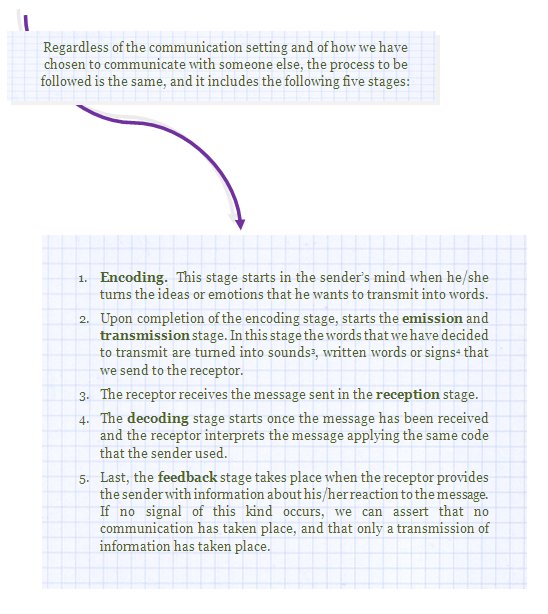
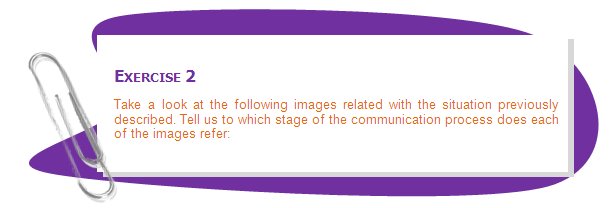
 |
 |
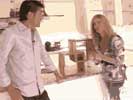 |
 |
 |
a |
b |
c |
d |
e |
The image must depict someone (standing at the side door of the house) thanking his/her neighbor (that has come over to call on him/her) |
The image must depict someone talking to his/her neighbor (the one speaking is the one that comes to the door – he/she is the one sending the message). |
The image must depict how the person standing at the door (the receiver) is processing the message received. |
The image must reflect someone thinking (he/she is thinking how to communicate the message) |
The image must depict two neighbors talking at the door of the house of one of them. It must show the message travelling through the air and reaching the neighbor that is at the door. |
 |
Regardless of the situation or the means used, when we refer to communication, we must always bear in mind that:
|
In this section we shall try and describe some concepts related with communication, such as (natural) languages, language and mother tongue. In addition, we shall go beyond this and provide a deeper insight on the functions of the language.
 |
Mostly, when we talk about communication we can’t help referring to the language, even sometimes we tend to use the concepts of languages (such as Spanish, English, etc.) and the language (capacity of communication) without distinction.
|
When you reflect upon the questions above you might have some doubts related with these two concepts. In order to understand better these two concepts you can reflect upon the following sentences:
According to many linguistic studies, between 5.500 and 6.800 natural languages are spoken around the world.
The European Union has 27 member states and 23 official languages.
Castilian is the only official language in Spain and it is spoken by most Spaniards.
Language is an important human feature. Animals also use language, but animal language consists of a limited set of signals that cannot compare with the great diversity and creativity of human language.
In order to verify that you actually know the differences between the aforementioned concepts, we want you to do the following exercise.
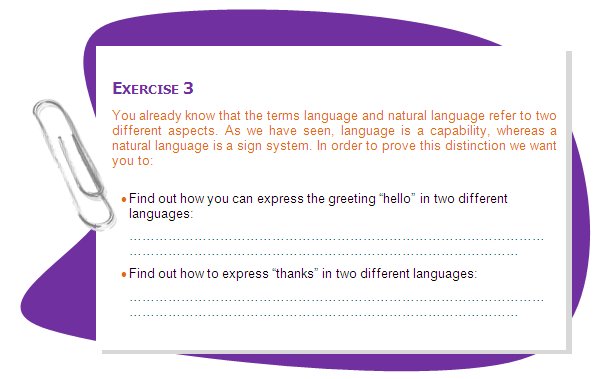
Our profieciency in the use of our mother tongue has a clear impact on our ability to learn, as it is commonly assumed that the mother tongue is the base of the processes of thought.
|
 |
As you know, when we want to communicate we use the language. But, which functions does language have in communication? Below, we include the different functions of language, based on this explanation, you must develop/complete examples for each communicative function:
Representative function: |
Example: |
The language allows us to provide information. |
|
Expressive function: |
Example: |
The language allows us to express opinions and emotions. |
|
Appelative function: |
Example: |
The language allows us to give orders and ask for somethings. |
|
Fatic function: |
Example: |
The lenguaje allows us to verify that the communication is effectively taking place. |
|
Poetic function: |
Example: |
The language can be used to communicate beauty (carefully chosen language mostly used in literatura). |
|
Linguistic function: |
Example: |
The language can be used to discuss language itself. |
In the last part of this Unit we shall discuss the different types of communication: verbal communication (oral and written) and non-verbal communication.
 |
Below, we have included a questionnaire to find out which are your likes and preferences in terms of transmitting and processing the information. How would you do the following?
|
As you have seen, depending on the information to be managed and especially on the specific circumstances of each communicative act, we decide to communicate in diverse ways.
Most probably you would never provide your personal data by means of gestures, or you would never let a child know that you are angry by sending him/her a note.
In order to communicate, we have different types of communciation that ensure that the information is conveyed in a suitable manner.
Verbal communication uses words to convey the information. It is known as oral communication if it uses spoken words, and as written communciation if it uses written words. |

|
Example:
|
|
Type of communication: Message: |
|
Type of communication: Message: |
|
Type of communication: Message: |
In most cases, we combine several types of communication to support the message that we want to convey and ensure that the receiver has perfectly understood our message.
According to several studies, when we communicate, we time is distributed in the following manner: speaking 30%, listening 45%, writing 10% and reading 15%. In the following units we shall analyze more into detail each of these communicative skills. |
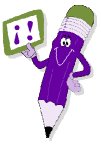 |
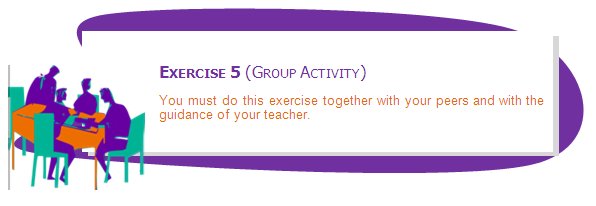
The students in the group must organize themselves into pairs. Each pair must be located in a different spot in the classroom, one member of the pair must be sitting, equipped with paper and pencil and leaning forward on the table, the other member of the pair must be standing and resting his/her back on his peer’s chair.
The teacher gives a worksheet to the one standing, who, without turning, must explain to his colleage, who is sitting, the content of the figure represented in the worksheet. The peer that is sitting must sketch the figure that his peer is describing.
 |
The student that is standing can only give spoken instructions, he/she must never turn to his/her peer.
|
 |
Upon completion of this activity, the whole group must reflect upon and share points of view about the following questions:
|
Both types of communication, verbal and non-verbal, are complementary, they support each other and are necessary to properly transmit the information and for the message to successfully reach the receptor. |
 |
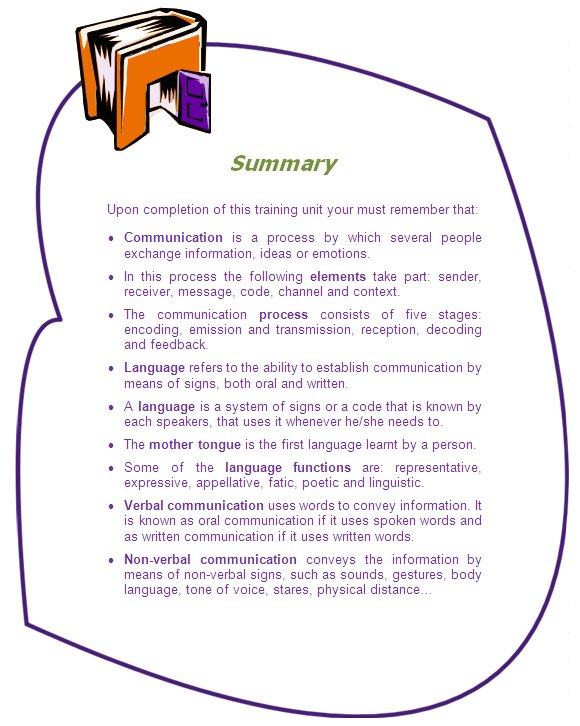
 |
Answers to the questions and exercises of Didactic Unit 1 |
Below, we suggest some examples similar to your answers to this activity:
The sender is a group of people.
The message is: Do not enter!
The code is written and the channel is a cell phone.
Below, we suggest possible answers to the questions:
The phrase “Thank you” in two different languages or natural languages:
Proposed images make reference to different communication types and the following messages are being transmitted:
 |
Example: |
|
Type of communication: Verbal communication (written communication). |
|
Type of communication: Verbal communication (written communication). |
|
Type of communication: Non-verbal communication. |